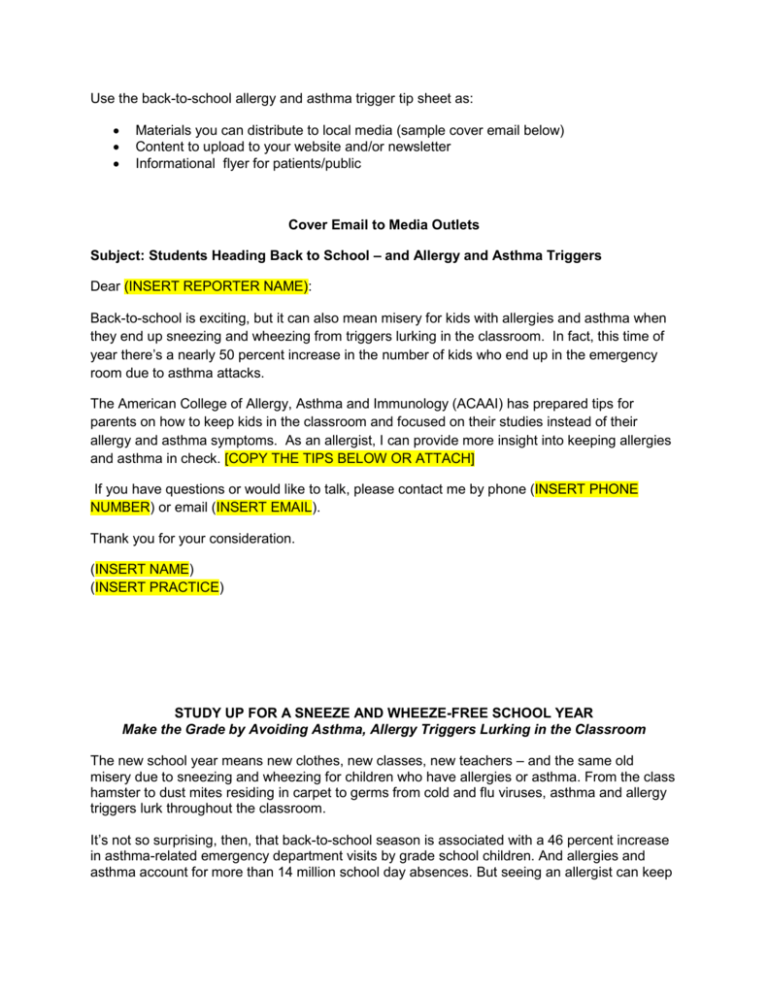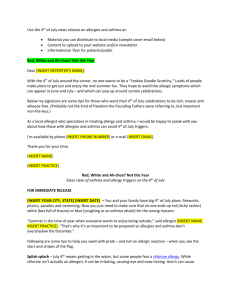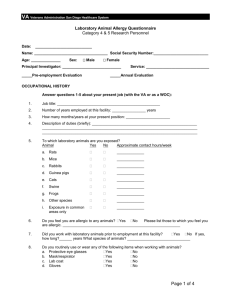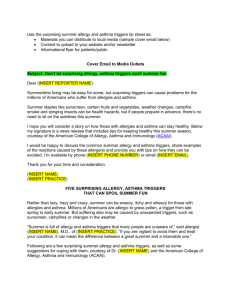Use the back-to-school allergy and asthma trigger tip sheet as
advertisement

Use the back-to-school allergy and asthma trigger tip sheet as: Materials you can distribute to local media (sample cover email below) Content to upload to your website and/or newsletter Informational flyer for patients/public Cover Email to Media Outlets Subject: Students Heading Back to School – and Allergy and Asthma Triggers Dear (INSERT REPORTER NAME): Back-to-school is exciting, but it can also mean misery for kids with allergies and asthma when they end up sneezing and wheezing from triggers lurking in the classroom. In fact, this time of year there’s a nearly 50 percent increase in the number of kids who end up in the emergency room due to asthma attacks. The American College of Allergy, Asthma and Immunology (ACAAI) has prepared tips for parents on how to keep kids in the classroom and focused on their studies instead of their allergy and asthma symptoms. As an allergist, I can provide more insight into keeping allergies and asthma in check. [COPY THE TIPS BELOW OR ATTACH] If you have questions or would like to talk, please contact me by phone (INSERT PHONE NUMBER) or email (INSERT EMAIL). Thank you for your consideration. (INSERT NAME) (INSERT PRACTICE) STUDY UP FOR A SNEEZE AND WHEEZE-FREE SCHOOL YEAR Make the Grade by Avoiding Asthma, Allergy Triggers Lurking in the Classroom The new school year means new clothes, new classes, new teachers – and the same old misery due to sneezing and wheezing for children who have allergies or asthma. From the class hamster to dust mites residing in carpet to germs from cold and flu viruses, asthma and allergy triggers lurk throughout the classroom. It’s not so surprising, then, that back-to-school season is associated with a 46 percent increase in asthma-related emergency department visits by grade school children. And allergies and asthma account for more than 14 million school day absences. But seeing an allergist can keep kids in the classroom: studies show patients treated by allergists for asthma have better symptom control, including less wheezing and fewer absences, at lower costs. “To keep kids focused on their studies instead of their allergy and asthma symptoms, it’s important that they receive proper diagnosis and treatment, as well as work with their parents to develop a plan for avoiding classroom triggers,” said Dr. (INSERT NAME), of (INSERT PRACTICE). Dr. (INSERT LAST NAME) is an allergist, a doctor who specializes in diagnosing and treating allergies. Make sure your child doesn’t suffer or miss school by following the advice, below, from Dr. (INSERT LAST NAME) and the American College of Allergy, Asthma and Immunology (ACAAI): Dust and mold and pollen, oh my – Many common triggers lie in wait for the allergic student. Dust mites and other allergens multiply in the class carpet, so suggest your child sit in a chair to read a book. Mold can grow in bathrooms and other dank areas, but are easily cleaned if brought to the janitor’s attention. And ask teachers to keep windows closed this fall and next spring to keep sneeze-prompting pollens out of the classroom. The germ incubator – It’s tough for the child with asthma to avoid germs at school, since they are pretty much everywhere from the pencil sharpener to the edge of the teacher’s desk. The best defense is a good offense, so be sure your child gets a seasonal flu shot. Washing hands regularly and using tissues and antibacterial hand sanitizers also can help. Tag, you’re – huff, puff – it – Jumping jacks during gym, tag during recess, soccer after school – these and other common school activities can trigger exercise-induced bronchoconstriction (EIB), commonly referred to as exercise induced asthma. About 80 percent to 90 percent of those with asthma have EIB and 10 percent of people without asthma have EIB. If your child has difficulty breathing during or after exercise, see an allergist who can work with you on a prevention and treatment plan. Be sure to give teachers, from gym to homeroom, a heads up and make sure your child has medication available at school. Fear of furry friends – Kids love class pets, but many have allergies to the hairy or furry variety. Allergic children should be reminded not to touch the pet. You also might suggest the teacher consider a non-furry pet, such as fish or a hermit crab, which offer plenty of learning opportunities without the allergy-triggering dander. Children who have pets at home also may have pet dander on their clothes, triggering symptoms in a petallergic child. A new seat assignment may help. Food safety patrol – If your child has food allergies, potential problems can crop up almost anywhere, from the lunchroom to the classroom. Tell the teacher about foods that cause problems for your child. Also be sure to alert scouting and other club leaders, and suggest an allergen-free snack policy). It‘s also important to teach your child about what foods might trigger a reaction and advise them to ask a teacher or adult before eating food they are unsure about. Share a plan with teachers, coaches and the school nurse for dealing with an allergic emergency and make sure your child has medications with them like injectable epinephrine. The back of the class – Sitting at the front of the classroom – near the chalkboard – is a bad idea for kids whose allergies or asthma are triggered by chalk dust. And washing hands after writing on the chalk board is a must. If your child is sneezing, wheezing and itching at school and you’re not sure why, see an allergist to find out what’s causing the problem and find relief. For more information about allergies in children, asthma in children, or take a self-relief test visit www.AllergyAndAsthmaRelief.org.






